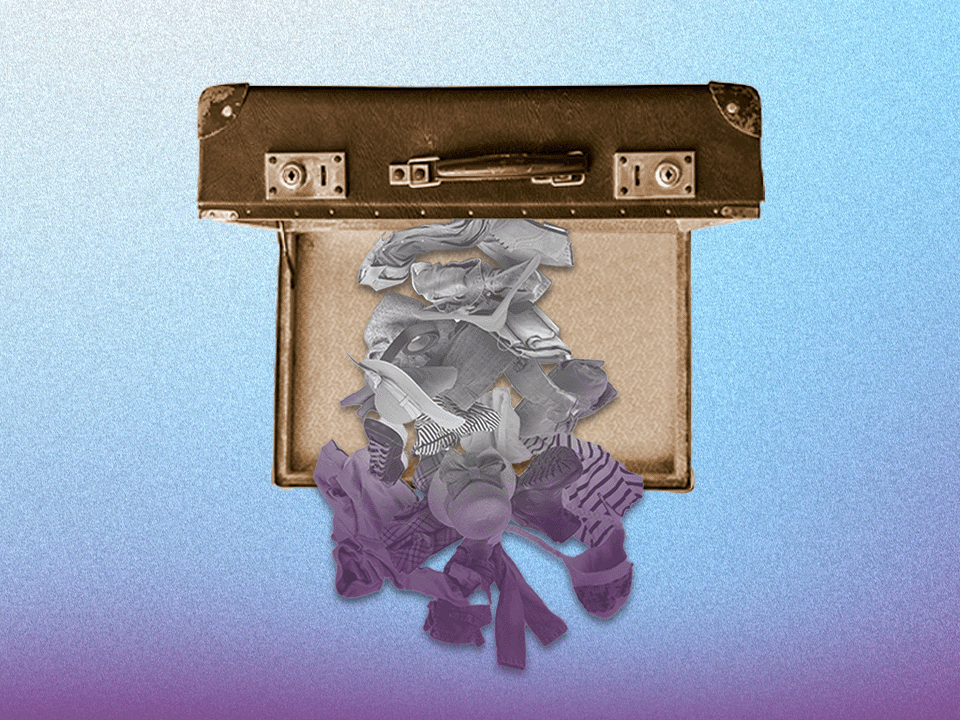What the Heck Is Trauma Dumping Anyway?
Oversharing about sensitive topics out of the blue? You might be a dumper.
Have you ever made a hard, hard pivot to a story about your near-death car accident in the middle of happy hour? Or casually dropped some childhood trauma on a coworker? Maybe you’ve shared a lot of details about your darkest moments on TikTok and added to the “trauma dumping” hashtag already flooded with videos of people doing the same.
According to the National Institute of Mental Health, half of adults in the U.S. experience at least one traumatic event in their lives, or what the American Psychological Association describes as a disturbing experience that causes lasting and intense “fear, helplessness, dissociation, confusion, or other disruptive feelings.” And, after a trauma, some shut down completely and don’t want to bring it up at all. Others confide in friends, family, whomever when they’re looking for support. And while discussing trauma might be just the thing you need, it could turn into “dumping” when the people you’re talking to aren’t necessarily ready to hear about it.
So what is trauma dumping?
While trauma dumping isn’t a clinical term, it’s exactly what it sounds like. “Think of it like a dump truck,” says therapist and certified complex trauma professional Luis Merced, LMHC. You’re unloading heavy, traumatic experiences onto people in your life, often without warning or consent from them, not really understanding how it might affect them. It can seem like too much too soon for the person on the receiving end because they’re hearing about trauma in, at times, graphic detail, he explains.
You might feel like you don’t have full control over what you’re saying (kind of like word vomit, if you will), and it could be hard to interrupt you, notes licensed clinical psychologist Lea Didion, PsyD, who specializes in PTSD treatment. Talking about your trauma can be somewhat of a relief if you’ve kept things in, but it can also leave you feeling shame, regret, and even more traumatized, says Dr. Didion.
Though trauma dumping seems similar to venting, the biggest difference is that venting usually doesn’t cross boundaries with the people you're talking to, says Merced. A venting sesh could still make the person you’re speaking with feel overwhelmed, but you aren’t giving unfiltered details about trauma.
Why do we trauma dump?
Trauma dumping can feel good because you’re getting things off your chest and mind (even if you’re low-key feeling shameful about it too). It can also be a way to look for connection even if you don’t realize that as you’re doing it, Dr. Didion says.
Sometimes, trauma dumping actually does make people feel closer to you because of how open you’re being, Dr. Didion adds. This sense of mutual connection can make your experience and your feelings about it seem validated, especially if you haven’t felt that way before.
For example, a parent could’ve made you think your emotions were unimportant or silly growing up, or you might experience race-based stress or trauma, Dr. Didion explains. If you’re used to being told that what you went through didn’t happen at all, trauma dumping can be a way to sort of test the waters. Whether you mean to or not, you’re seeing if someone will reject you like you’ve been rejected before, Dr. Didion says. That’s especially true if the person you’re dumping on is a new friend or potential partner.
Also, whether you realize or not, you could be trauma dumping to prove you are suffering or to be taken seriously. Living in a time where the news and social media bring real-time trauma right to us, people can feel like they need to share what they went through to be seen, Dr. Didion says. “We sometimes don't pay attention to somebody until they are broken down, no reserves left, crying, having these large outpourings of emotion. And then, we take notice,” she explains.
Is trauma dumping bad?
Nope, it’s not bad. And if you’re doing it because of a need to be heard, validated, seen, valued, etc., etc., etc., etc., it’s OK. “It’s a completely normal need that every human being walks around with every single day,” Dr. Didion says.
That said, trauma dumping might not get you to the outcome you’re looking for, says Dr. Didion. When you’re trying to connect with someone you just met, for example, trauma dumping can “flood an early relationship with heavy stuff before you’ve really built the foundation of trust,” she says. The person you’re talking to might not know how to respond and could believe you’ve crossed a line with them. In turn, you could feel more shame and invalidation, she adds.
If you’re hoping to connect with someone you’ve known longer, dumping trauma still might not feel great to either of you, but they’re more likely to respond in a way that is supportive and soothing, which can foster this feeling of closeness, Dr. Didion explains. If they do get overwhelmed, there’s more of a chance that you can move forward and repair the vibe between you.
What you can do about your trauma dumping.
If you have a hunch that you already said too much, try not to be super hard on yourself since, as mentioned, you might not have full control over what you’re saying in the first place. Know that whenever you bring up any negative experience, the other person will probably feel some type of way about it, even if it’s just a small reaction, Merced says.
But, if you’re consciously looking to share your traumatic experience with someone (like with your best friend or the person you’ve been dating for a while) and you’re not sure if it will turn into a dump, you can preface that convo with a heads up about what you’re going to dive into. Then, be sure to ask them to stop you when it gets to be too much for them, says Dr. Didion. You can also check in mid-convo and say, “I know I loaded a lot on you. How’re you doing?” suggests Merced.
FYI, a person on the other end of a trauma dump might say they know their limits but not actually know what they can handle, says Dr. Didion. It isn’t all on you.
Also! If you’re thinking about dropping your trauma on social media, take a min to slow down first and consider what you’re hoping to get out of posting, Dr. Didion says. “If you need to speak up and stand in your truth, then there is absolutely power in that!” she says. It’s good to use some type of trigger warning so people who see your content know what’s coming. If you’re looking for nice comments or likes, then consider who your followers actually are and if you’ll be able to get empathy or support from that, Dr. Didion says (not getting empathy, as you can imagine, could just make you feel worse).
What to do if you’re being trauma dumped on.
When you’re on the receiving end, definitely communicate your boundaries. If you’re comfortable, you can mention that you need a break, says Dr. Didion. Maybe it’s something like, “Hey, you’re sharing a lot, and I want to be here for you, but I need a minute to digest everything right now.” Maybe you suggest both of you take a breather and continue the conversation later, or maybe the next time you’re together, you suggest that they talk to someone else who may or may not be a therapist (here are non-shamey ways to do that).
When you come across a social post that feels triggering for you on your IG feed, TikTok FYP, whatever, find ways to soothe yourself, says Dr. Didion. You could put your phone away and watch some Hallmark Christmas movies, pet your dog, or go for a walk. Allow yourself to rest or reach out for help you might need, she says.
Where to find trauma support.
If you’re looking to talk about your trauma with someone who’s actually trained to help you work on healing, consider checking out trauma therapy, where you can process your trauma and learn skills for how to cope. Dr. Didion suggests you search for a mental health professional who specializes in EMDR, prolonged exposure, and/or cognitive processing therapy since, even if you don’t go through with any of those treatments, it shows that the therapist has trauma-informed training. Good places to look? Psychology Today or the National Center for PTSD.
Wondermind does not provide medical advice, diagnosis, or treatment. Any information published on this website or by this brand is not intended as a replacement for medical advice. Always consult a qualified health or mental health professional with any questions or concerns about your mental health.




